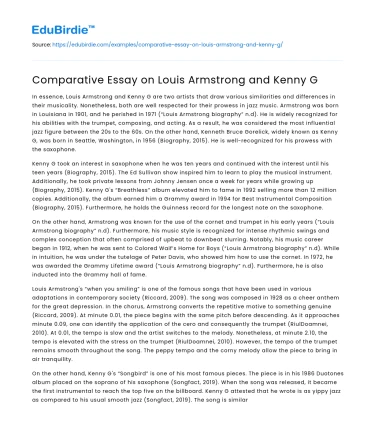In essence, Louis Armstrong and Kenny G are two artists that draw various similarities and differences in their musicality. Nonetheless, both are well respected for their prowess in jazz music. Armstrong was born in Louisiana in 1901, and he perished in 1971 (“Louis Armstrong biography” n.d). He is widely recognized for his abilities with the trumpet, composing, and acting. As a result, he was considered the most influential jazz figure between the 20s to the 60s. On the other hand, Kenneth Bruce Gorelick, widely known as Kenny G, was born in Seattle, Washington, in 1956 (Biography, 2015). He is well-recognized for his prowess with the saxophone.
Kenny G took an interest in saxophone when he was ten years and continued with the interest until his teen years (Biography, 2015). The Ed Sullivan show inspired him to learn to play the musical instrument. Additionally, he took private lessons from Johnny Jensen once a week for years while growing up (Biography, 2015). Kenny G's “Breathless” album elevated him to fame in 1992 selling more than 12 million copies. Additionally, the album earned him a Grammy award in 1994 for Best Instrumental Composition (Biography, 2015). Furthermore, he holds the Guinness record for the longest note on the saxophone.
Save your time!
We can take care of your essay
- Proper editing and formatting
- Free revision, title page, and bibliography
- Flexible prices and money-back guarantee
On the other hand, Armstrong was known for the use of the cornet and trumpet in his early years (“Louis Armstrong biography” n.d). Furthermore, his music style is recognized for intense rhythmic swings and complex conception that often comprised of upbeat to downbeat slurring. Notably, his music career began in 1912, when he was sent to Colored Waif’s Home for Boys (“Louis Armstrong biography” n.d). While in intuition, he was under the tutelage of Peter Davis, who showed him how to use the cornet. In 1972, he was awarded the Grammy Lifetime award (“Louis Armstrong biography” n.d). Furthermore, he is also inducted into the Grammy hall of fame.
Louis Armstrong's “when you smiling” is one of the famous songs that have been used in various adaptations in contemporary society (Riccard, 2009). The song was composed in 1928 as a cheer anthem for the great depression. In the chorus, Armstrong converts the repetitive motive to something genuine (Riccard, 2009). At minute 0.01, the piece begins with the same pitch before descending. As it approaches minute 0.09, one can identify the application of the cero and consequently the trumpet (RiulDoamnei, 2010). At 0.01, the tempo is slow and the artist switches to the melody. Nonetheless, at minute 2.10, the tempo is elevated with the stress on the trumpet (RiulDoamnei, 2010). However, the tempo of the trumpet remains smooth throughout the song. The peppy tempo and the corny melody allow the piece to bring in air tranquility.
On the other hand, Kenny G's “Songbird” is one of his most famous pieces. The piece is in his 1986 Duotones album placed on the soprano of his saxophone (Songfact, 2019). When the song was released, it became the first instrumental to reach the top five on the billboard. Kenny G attested that he wrote is as yippy jazz as compared to his usual smooth jazz (Songfact, 2019). The song is similar to that of Armstrong as they are both composed to raise the mood of the audience. The piece begins with an ascending tempo at minute 0.15; however, at minute 0.55, he switches the tempo of the music between fast and slow. That is, the tempo rises at 0.55 and later descends at minute 1.05 (KennyGVEVO, 2011). Although the piece is written from a different perspective, it is still under the same category as it sets on in a sober mood. Although both artists have used different instruments, their music has similar aesthetics of a calming effect.






 Stuck on your essay?
Stuck on your essay?

